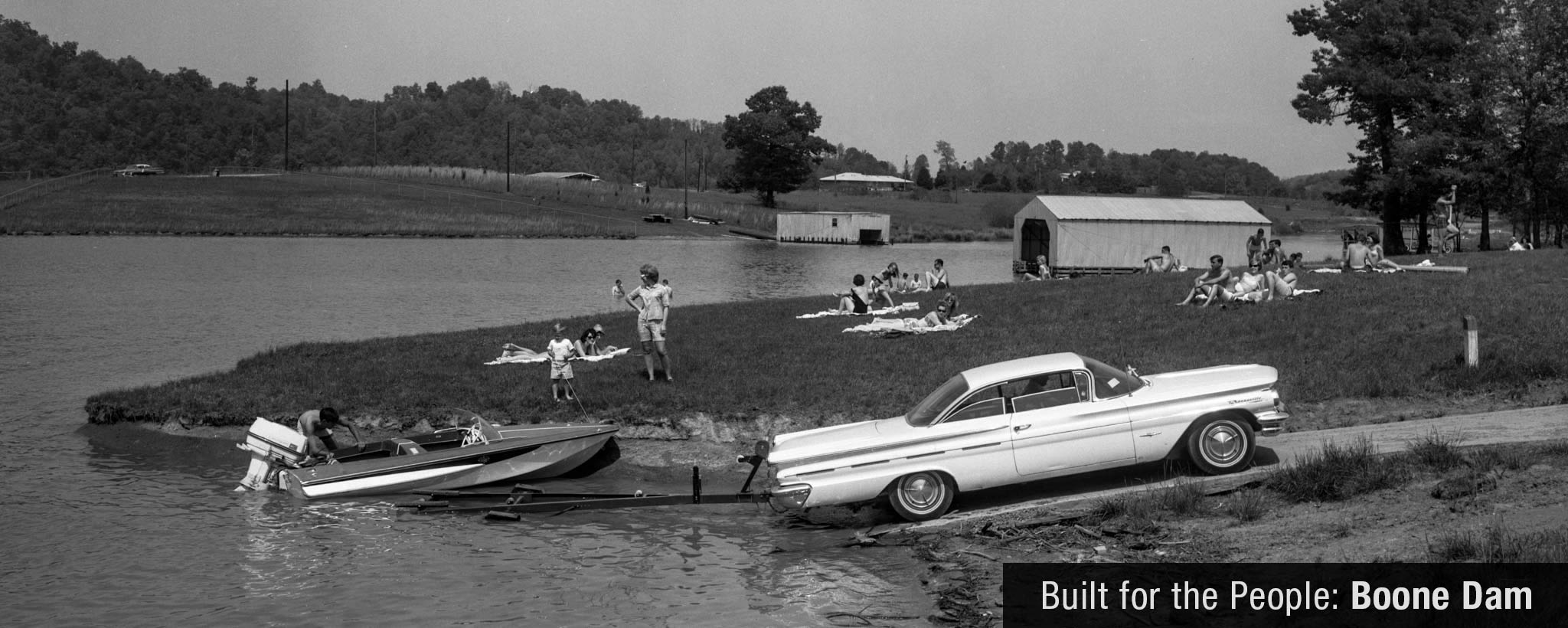
Power for Peacetime
TVA’s wartime dam-building program was mighty, but demand for electricity didn’t stop with the ceasefire. Boone Dam, authorized in 1950, would help energize the baby boom.
Against the backdrop of World War II, TVA launched one of the largest hydropower construction programs ever undertaken in the United States. The nation urgently needed power to fuel the war effort, and TVA took up the cause.
Although the war ended in 1945, the nation’s thirst for electricity pressed on. The private economy boomed as the government sector soldiers returned home and started new families. Factories that once made bombs now made cars, televisions and a host of modern household appliances. New industries such as aviation and electronics grew by leaps and bounds. Electricity use skyrocketed as a result, sending utility companies—TVA included—scurrying to create new capacity.
The Logical Step
TVA’s plan for providing the needed power (and for controlling flooding in the Tennessee River watershed) included four dams on the South Fork Holston River in upper East Tennessee. Congress authorized two of those dams — Watauga and South Holston—during the war years, and they were nearing completion in the late 1940s. Construction of Boone Dam, downstream, was TVA’s next logical step.
Congress gave TVA the okay to build Boone Dam in August of 1950, and work began at the site almost immediately. The new dam was completed and its gates closed December 6, 1952—an achievement credited to TVA’s ability to transfer equipment and workers with years of experience in dam construction from one project to another.
A Flood Stopper
While the need for electricity all but overshadowed everything else during the war years, TVA engineers never lost sight of the fact that the dams they were building were to serve peacetime purposes. Chief among these was flood management.
In making the case for Boone to Congress, TVA explained that the storage capacity the dam would create would be particularly strategic in controlling and preventing floods in the downstream city of Kingsport, Tenn., which had suffered major flood damage in 1901 and 1940.
Proof wasn’t long in coming. Widespread and heavy rains began falling on the already saturated ground in northeastern Tennessee on January 27, 1957, and continued for seven straight days. By holding back the floodwaters in the upstream reservoirs created by South Holston, Watauga and Boone dams, TVA flood control operations kept the water level at Kingsport substantially below a damaging flood stage and helped to reduce flooding at Chattanooga, Tenn., by about 22 feet.
Boone Dam also contributed to flood damage reduction at Kingsport and at Chattanooga during potentially damaging rain events in 1957, 1962, 1963, 1984, 2004 and, recently, in December 2015.
Another Fishing Paradise
Boone also brought recreational benefits. Local residents had high hopes that the new reservoir would become, as one newspaper reported, “another fishing paradise,” comparable to other TVA lakes, such as South Holston. On June 14, 1954, when the new lake “opened,” a host of anglers were ready to compete for the first catch while crews from local rescue squads patrolled assigned areas to ensure everyone’s safety.
Today, fishing is still a part of Boone’s draw, along with opportunities to boat, swim and camp. Recreation on the scenic reservoir is of tremendous importance to the people who live in the area and to the local economy.
Happening Now: Safety Repairs
During construction of Boone Dam, workers encountered voids and soft muddy soils in part of the ground called the “epikarst.” To limit groundwater seepage under the dam, engineers created a deep “cutoff trench” to remove the voids and soft soils and pumped grout into the foundation to fill any remaining voids—a state of the art foundation treatment in the 1950s.
During an inspection in October 2014, TVA discovered a sinkhole near the base of the embankment at Boone Dam. Further study revealed deterioration of the cutoff trench, allowing seepage flows that continue to undermine the foundation of the dam.
TVA is currently in the process of fixing the problem. Click here for detailed information and the latest project updates.
